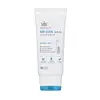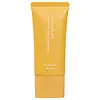What's inside
What's inside
 Key Ingredients
Key Ingredients

 Benefits
Benefits

 Concerns
Concerns

 Ingredients Side-by-side
Ingredients Side-by-side

Aloe Barbadensis Extract
Skin ConditioningLaminaria Japonica Extract
Skin ProtectingDioscorea Japonica Root Extract
Skin ConditioningWater
Skin ConditioningHomosalate
Skin ConditioningSilica
AbrasiveEthylhexyl Salicylate
UV AbsorberButyl Methoxydibenzoylmethane
UV AbsorberButylene Glycol
HumectantNiacinamide
SmoothingBis-Ethylhexyloxyphenol Methoxyphenyl Triazine
Skin ConditioningIsoamyl P-Methoxycinnamate
UV AbsorberOctocrylene
UV AbsorberMethoxy PEG/PPG-25/4 Dimethicone
EmulsifyingBis-PEG/PPG-20/5 PEG/PPG-20/5 Dimethicone
EmulsifyingPEG-10 Dimethicone
Skin ConditioningCaprylic/Capric Triglyceride
MaskingCaprylyl Glycol
EmollientPhenoxyethanol
PreservativeAcrylates/C10-30 Alkyl Acrylate Crosspolymer
Emulsion StabilisingEthylhexylglycerin
Skin ConditioningTocopheryl Acetate
AntioxidantParfum
MaskingPotassium Hydroxide
Buffering1,2-Hexanediol
Skin ConditioningCarbomer
Emulsion StabilisingAdenosine
Skin ConditioningDisodium EDTA
Sodium Guaiazulene Sulfonate
Aloe Barbadensis Leaf Extract
EmollientLimonia Acidissima Extract
Skin ConditioningGlycerin
HumectantBiosaccharide Gum-4
Skin ConditioningHydrolyzed Hyaluronic Acid
HumectantAloe Barbadensis Extract, Laminaria Japonica Extract, Dioscorea Japonica Root Extract, Water, Homosalate, Silica, Ethylhexyl Salicylate, Butyl Methoxydibenzoylmethane, Butylene Glycol, Niacinamide, Bis-Ethylhexyloxyphenol Methoxyphenyl Triazine, Isoamyl P-Methoxycinnamate, Octocrylene, Methoxy PEG/PPG-25/4 Dimethicone, Bis-PEG/PPG-20/5 PEG/PPG-20/5 Dimethicone, PEG-10 Dimethicone, Caprylic/Capric Triglyceride, Caprylyl Glycol, Phenoxyethanol, Acrylates/C10-30 Alkyl Acrylate Crosspolymer, Ethylhexylglycerin, Tocopheryl Acetate, Parfum, Potassium Hydroxide, 1,2-Hexanediol, Carbomer, Adenosine, Disodium EDTA, Sodium Guaiazulene Sulfonate, Aloe Barbadensis Leaf Extract, Limonia Acidissima Extract, Glycerin, Biosaccharide Gum-4, Hydrolyzed Hyaluronic Acid
Water
Skin ConditioningGlycerin
HumectantCyclopentasiloxane
EmollientNylon-12
Butyl Methoxydibenzoylmethane
UV AbsorberEthylhexyl Methoxycinnamate
UV AbsorberSilica
AbrasiveButylene Glycol
HumectantOctocrylene
UV AbsorberPolysilicone-34
Skin ConditioningArtemisia Capillaris Flower Extract
Skin ConditioningKaolin
AbrasiveAloe Barbadensis Extract
Skin ConditioningCamellia Sinensis Leaf Extract
AntimicrobialTocopheryl Acetate
AntioxidantPhenoxyethanol
PreservativeLecithin
EmollientIsononyl Isononanoate
EmollientDimethicone/Vinyl Dimethicone Crosspolymer
Skin ConditioningTriethylene Glycol
MaskingWater, Glycerin, Cyclopentasiloxane, Nylon-12, Butyl Methoxydibenzoylmethane, Ethylhexyl Methoxycinnamate, Silica, Butylene Glycol, Octocrylene, Polysilicone-34, Artemisia Capillaris Flower Extract, Kaolin, Aloe Barbadensis Extract, Camellia Sinensis Leaf Extract, Tocopheryl Acetate, Phenoxyethanol, Lecithin, Isononyl Isononanoate, Dimethicone/Vinyl Dimethicone Crosspolymer, Triethylene Glycol
 Reviews
Reviews

Ingredients Explained
These ingredients are found in both products.
Ingredients higher up in an ingredient list are typically present in a larger amount.
Aloe Barbadensis Extract is the extract of the whole Aloe plant. It has anti-inflammatory, moisturizing, antiseptic, and healing properties.
Aloe contains the antioxidants Vitamins A, C, and E. . These vitamins neutralize free radicals.
It also contains sugars in the form of monosaccharides and polysaccharides, folic acid, choline, many common minerals such as calcium, 12 anthraquinones, fatty acids, amino acids, and Vitamin B12.
The polysaccharides in aloe help moisturize your skin.
Despite helping with sunburn, aloe should not replace your sunscreen.
Learn more about Aloe Barbadensis ExtractAlso known as Avobenzone, this ingredient is a chemical sunscreen filter that provides protection in the UV-A range.
Avobenzone is globally approved and is the most commonly used UV-A filter in the world.
Studies have found that avobenzone becomes ineffective when exposed to UV light (it is not photostable; meaning that it breaks down in sunlight). Because of this, formulations that include avobenzone will usually contain stabilizers such as octocrylene.
However, some modern formulations (looking at you, EU!) are able to stabilize avobenzone by coating the molecules.
Avobenzone does not protect against the UV-B range, so it's important to check that the sunscreen you're using contains other UV filters that do!
The highest concentration of avobenzone permitted is 3% in the US, and 5% in the EU.
Learn more about Butyl MethoxydibenzoylmethaneButylene Glycol (or BG) is used within cosmetic products for a few different reasons:
Overall, Butylene Glycol is a safe and well-rounded ingredient that works well with other ingredients.
Though this ingredient works well with most skin types, some people with sensitive skin may experience a reaction such as allergic rashes, closed comedones, or itchiness.
Learn more about Butylene GlycolGlycerin is already naturally found in your skin. It helps moisturize and protect your skin.
A study from 2016 found glycerin to be more effective as a humectant than AHAs and hyaluronic acid.
As a humectant, it helps the skin stay hydrated by pulling moisture to your skin. The low molecular weight of glycerin allows it to pull moisture into the deeper layers of your skin.
Hydrated skin improves your skin barrier; Your skin barrier helps protect against irritants and bacteria.
Glycerin has also been found to have antimicrobial and antiviral properties. Due to these properties, glycerin is often used in wound and burn treatments.
In cosmetics, glycerin is usually derived from plants such as soybean or palm. However, it can also be sourced from animals, such as tallow or animal fat.
This ingredient is organic, colorless, odorless, and non-toxic.
Glycerin is the name for this ingredient in American English. British English uses Glycerol/Glycerine.
Learn more about GlycerinOctocrylene protects skin from sun damage. It absorbs UV-B with peak absorption of 304 nm. It is a common sunscreen ingredient and often paired with avobenzone, a UVA filter. This is because octocrylene stabilizes other sunscreen ingredients by protecting them from degradation when exposed to sunlight. Octocrylene is a photostable ingredient and loses about 10% of SPF in 95 minutes.
Octocrylene also acts as an emollient, meaning it helps skin retain moisture and softens skin. It is oil-soluble and hydrophobic, enhancing water-resistant properties in a product.
Those who are using ketoprofen, a topical anti-inflammatory drug, may experience an allergic reaction when using octocrylene. It is best to speak with a healthcare professional about using sunscreens with octocrylene.
The EU allows a maximum of these concentrations:
Learn more about OctocrylenePhenoxyethanol is a preservative that has germicide, antimicrobial, and aromatic properties. Studies show that phenoxyethanol can prevent microbial growth. By itself, it has a scent that is similar to that of a rose.
It's often used in formulations along with Caprylyl Glycol to preserve the shelf life of products.
Silica, also known as silicon dioxide, is a naturally occurring mineral. It is used as a fine, spherical, and porous powder in cosmetics.
Though it has exfoliant properties, the function of silica varies depending on the product.
The unique structure of silica enhances the spreadability and adds smoothness, making it a great texture enhancer.
It is also used as an active carrier, emulsifier, and mattifier due to its ability to absorb excess oil.
In some products, tiny microneedles called spicules are made from silica or hydrolyzed sponge. When you rub them in, they lightly polish away dead skin layers and enhance the penetration of active ingredients.
Learn more about SilicaTocopheryl Acetate is AKA Vitamin E. It is an antioxidant and protects your skin from free radicals. Free radicals damage the skin by breaking down collagen.
One study found using Tocopheryl Acetate with Vitamin C decreased the number of sunburned cells.
Tocopheryl Acetate is commonly found in both skincare and dietary supplements.
Learn more about Tocopheryl AcetateWater. It's the most common cosmetic ingredient of all. You'll usually see it at the top of ingredient lists, meaning that it makes up the largest part of the product.
So why is it so popular? Water most often acts as a solvent - this means that it helps dissolve other ingredients into the formulation.
You'll also recognize water as that liquid we all need to stay alive. If you see this, drink a glass of water. Stay hydrated!
Learn more about Water